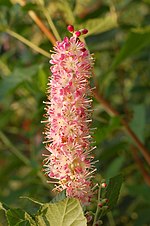| Clethra alnifolia | |
|---|---|

| |
| Scientific classification | |
| Kingdom: | Plantae |
| Clade: | Tracheophytes |
| Clade: | Angiosperms |
| Clade: | Eudicots |
| Clade: | Asterids |
| Order: | Ericales |
| Family: | Clethraceae |
| Genus: | Clethra |
| Species: | C. alnifolia |
| Binomial name | |
| Clethra alnifolia L. | |
| Synonyms | |
| |
Clethra alnifolia, the coastal sweetpepperbush or summer sweet, is a species of flowering plant in the genus Clethra of the family Clethraceae, native to eastern North America from southern Nova Scotia and Maine south to northern Florida, and west to eastern Texas. It is a deciduous shrub which grows in wetlands, bogs and woodland streams.
Description
Growing to 1.5–3 m (4 ft 11 in – 9 ft 10 in) tall, it is a deciduous shrub. The leaves are obovate to oblong, 4–10 cm long and 2–4 cm broad, with a serrated margin; they are green turning yellow-golden during the autumn. The flowers are white or very pale pink, 5–10 mm in diameter, and have a sweet, somewhat cloying fragrance. The flowers, which are attractive to bumblebees, are produced in racemes up to 15 cm long and 2 cm broad in late summer, depending on the cultivar. The scent of C. alnifolia is described as sweet. The "pepper" part of the common name derives from the mature fruits, capsules which have a vague resemblance to peppercorns, however with no element of spiciness.
Habitat
It grows in wet forests, pine flatwoods, wetlands, bogs and can be seen alongside woodland streams. It prefers a neutral to acidic soil. The Nova Scotia population is small and endangered.
Etymology
The Latin specific epithet alnifolia means "with leaves like alder (Alnus)". This gave rise to another common name, common white alder, though the two plants are not closely related.

Cultivation
C. alnifolia is typically used as a shrub for natural gardens, or is placed alongside a stream or pond to delay erosion. It does not leaf out until very late in the season, limiting its landscaping use. Several cultivars have been selected for garden use, including 'September Beauty'. Both 'Ruby Spice', with strongly pink flowers, and the dwarf 'Hummingbird' have gained the Royal Horticultural Society's Award of Garden Merit (confirmed 2017).
References
- "The Plant List: A Working List of All Plant Species". Retrieved 19 September 2015.
- "Clethra alnifolia (Alderleaf Clethra, Alderleaf Pepperbush, Clethra, Coastal Sweet-pepperbush, Summersweet, Sweet Pepperbush) | North Carolina Extension Gardener Plant Toolbox". plants.ces.ncsu.edu. Retrieved 2021-11-03.
- HEMINGSON, JOYCE CANFIELD (1986). THE POLLINATION BIOLOGY OF CLETHRA ALNIFOLIA L. (CLETHRACEAE) (ESSENTIAL OIL, CHEMICAL ECOLOGY, FLORAL ODOR) (Thesis).
- Harrison, Lorraine (2012). RHS Latin for Gardeners. United Kingdom: Mitchell Beazley. ISBN 978-1845337315.
- ^ "RHS Plantfinder - Clethra alnifolia 'Ruby Spice'". Retrieved 30 January 2018.
- "RHS Plantfinder - Clethra alnifolia 'Hummingbird'". Retrieved 30 January 2018.
- "AGM Plants - Ornamental" (PDF). Royal Horticultural Society. July 2017. p. 16. Retrieved 24 January 2018.
External links
- Connecticut Botanical Society Archived 2006-09-10 at the Wayback Machine
- Virginia Tech Dendrology
- Canadian Biodiversity: Clethra alnifolia in Nova Scotia
| Taxon identifiers | |
|---|---|
| Clethra alnifolia |
|